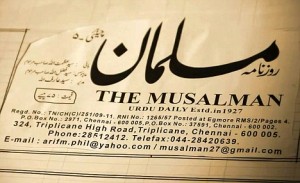In the age of internet technology, digital printing and 24-hour news channels, the headlines have never travelled faster.
But in a resilient and elegant corner of India, the traditions of generations past are being kept alive on the world’s last hand-written daily newspaper.
At 324 Triplicane High Road in Chennai, the staff of the Urdu language evening paper The Musalman literally write the headlines every day.
It takes three hours for the three katibs – specialist calligraphers and reporters – to pen a page, before it is turned into a negative, printed, folded and sold to its 21,000 subscribers.
Late-breaking news stories previously meant that whole pages needed to be re-written, but a blank panel in the corner of the front page now caters for that event.
Mistakes on the other hand, can lead to a whole page being scrapped and rewritten.
The tradition of calligraphy in India dates back to the days when entire Koran’s were hand-written and up until the 1980s all Urdu newspapers were made that way.
But once digital printing technology became readily available the newspapers all succumbed, understandably, to the march of progress. Not the Musalman, though.
It’s adherence to tradition is viewed now as a matter of life and death for its editor Syed Arifullah, who took over control after the death of his father.
‘We have been maintaining the tradition for the last 84 years, and after my first three years in charge I decided to dedicate my life to Musalman,’ said Mr Arifullah.
‘The Muslaman is all about the calligraphy, everybody is attracted by the calligraphy, if you switch to computer what is there different between us and other newspapers?
‘Calligraphy is the heart of Musalman. If you take out the heart, there is nothing left.’
The paper was founded in 1927 by Mr Arifullah’s grandfather, Syed Azmathullah, and he passed on the editorship to Mr Arifullah’s father, Syed Faizullah, who was editor until he died, aged 76, after a lung infection.
For its staff, The Musalman represents a dying art and their participation helps preserve not only the ancient tradition but also the relatively small Urdu language.
And any boss would long for staff as loyal as those at the command of Mr Arifullah.
Chief reporter Rehman Hussain, 50, has been with the paper for more than 30 years and says; ‘Because of our knowledge of Urdu we are respected – I will be with Musalman until my last breath.’
Perhaps that lifelong dedication is a result of the method of promotion that often occurs in the newsroom.
Rahman joined initially as an accountant but then learned calligraphy on the job and and when the then-chief katib passed away at the age of 80, he took over.
Mr Hussein says no one has ever quit – the staff work there until till they move on to the great newsroom in the sky.
It is not an easy place to work. The newsroom is badly lit, there is no air-conditioning and it is noisy because the printing press is in the same 800sq ft office.
The pay is relatively low and profits are virtually non-existent as costs are barely covered, but for those who handcraft The Musalman, it is a vocation.
Usman Gani, the paper’s beautifully eloquent sub-editor, says: ‘It is my love for doing this that is keeping me attached to Musalman.
Source: Mail Online










Comments